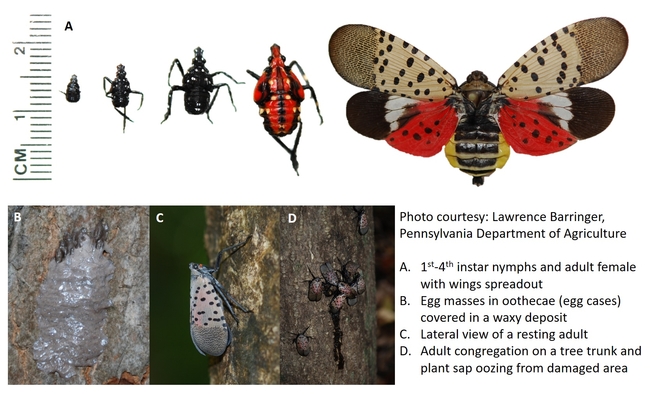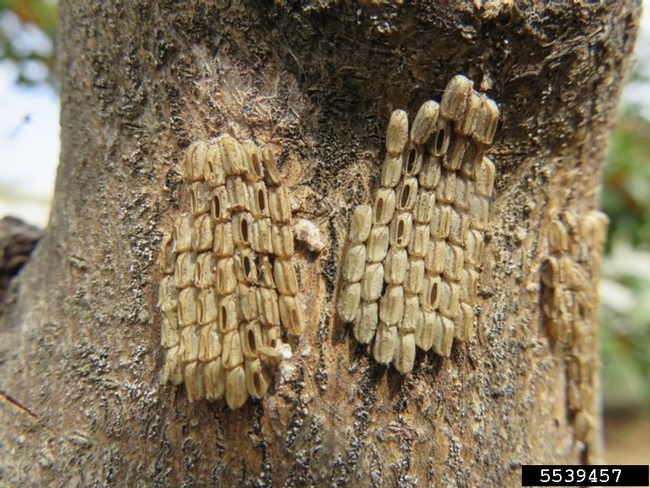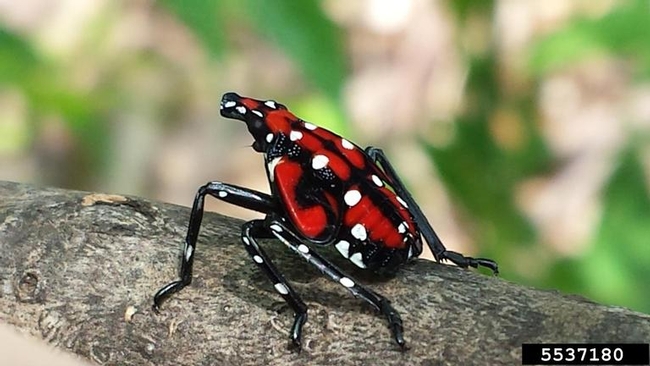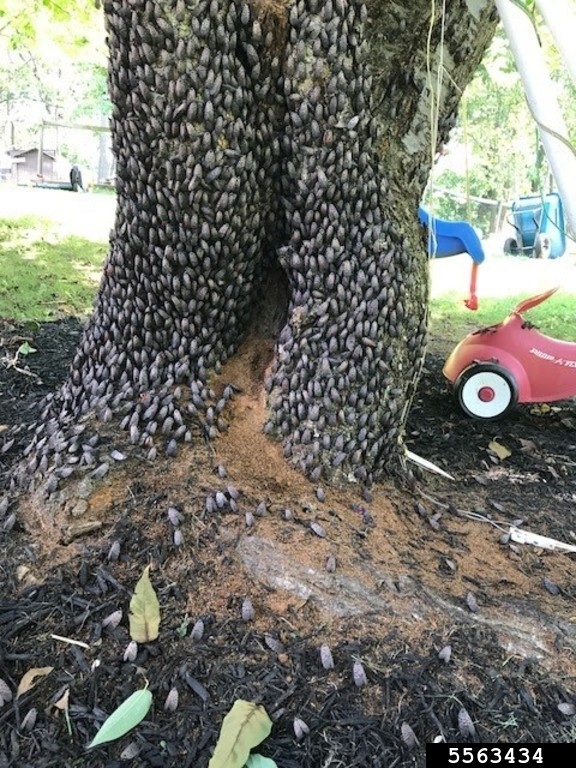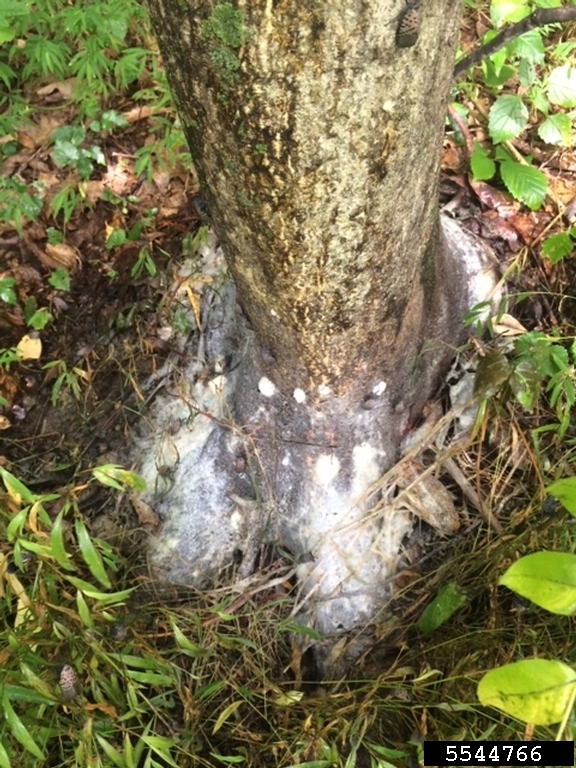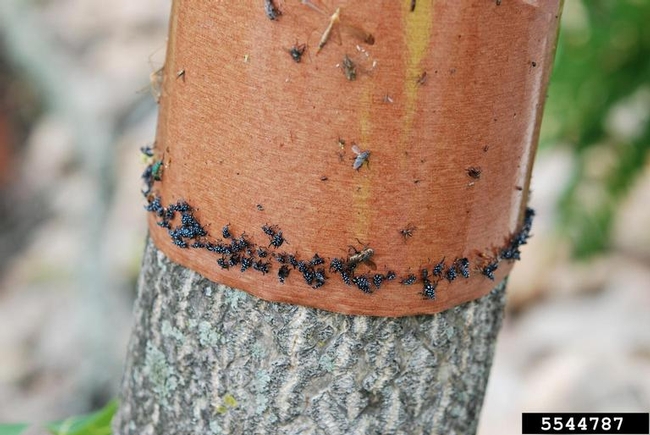An update on the invasive spotted lanternfly, Lycorma delicatula: current distribution, pest detection efforts, and management strategies
Spotted lanternfly (Lycorma delicatula) is an invasive planthopper that was first detected in Pennsylvania in September, 2014 (Dara et al., 2015) and believed to have arrived as eggs attached to stone in a shipment of stone from Asia. This pest is native to China and has been reported in some other Asian countries. Since its first occurrence in Berks County in Pennsylvania, it has now spread to 13 counties in the state and was also reported in Delaware and New York in November, 2017 and in Virginia in January, 2018.
Fruit trees (apple, apricot, cherry, peach), ornamental or woody trees (birch, lilac, maple, poplar, tree of heaven), and vines (grape) are among more than 70 species of hosts that are infested by spotted lanternfly. The tree of heaven (Ailanthus altissima) is a favorite of the spotted lanternfly. Several invasive pests such as the brown marmorated stink bug and the Asian citrus psyllid first found in late 90s in Pennsylvania and Florida, respectively, have spread to other states and are now found in California. Considering its current distribution of the spotted lanternfly in Pennsylvania and other states and its potential to spread to other states, this article provides an update on recent efforts to monitor and control this pest.
Biology and damage
Eggs are deposited in masses and covered by a waxy substance. There are four nymphal instars. Female lanternflies are larger than males. Nymphs and adults feed on the phloem and excrete large volumes of liquid. Severe feeding damage results in oozing wounds on the trunk, and wilting and death of affected branches.
Egg masses of the spotted lanternfly. Photo by Lawrence Barringer, Pennsylvania Department of Agriculture.
Fourth instar nymph of the spotted lanternfly. Photo by Lawrence Barringer, Pennsylvania Department of Agriculture.
Adult spotted lanternfly infestations. Photo by Lawrence Barringer, Pennsylvania Department of Agriculture.
White mold developing on the excretions of the spotted lanternfly. Photo by Lawrence Barringer, Pennsylvania Department of Agriculture.
Monitoring and controlling
Preventing the movement: To prevent the spread of the spotted lanternfly, carefully inspect potential sources such as woody plant debris, yard waste, plants, or other objects. Destroy or disinfest the sources as appropriate to prevent the spread of the pest.
Removal of the host: Removing tree of heaven, a favorite host of the spotted lanternfly and an invasive species of tree, can reduce the risk of pest infestation and spread. Reducing the plant stand to 15% is considered a primary strategy for preventing the spread of spotted lanternfly. The tree should be removed with its entire root system when possible. If the tree was cut, its stump should be treated with herbicides to prevent regrowth. Care should be taken while removing the tree of heaven since the toxic plant sap can cause skin irritation, headaches, nausea, and in some cases cardiac problems. Sumac and black walnut trees also look similar to the tree of heaven, but when bruised, the leaves of the latter give out a rancid peanut butter odor.
Sticky bands: The Pennsylvania Department of Agriculture placed 13 counties under quarantine and is currently providing sticky bands for volunteers participating in the monitoring program to place on trees. Sticky bands are placed around the tree trunk about 4' from the ground to trap the nymphs and adults that are moving around. While younger nymphs can be captured on less sticky bands, stickier bands are necessary to capture older nymphs and adult hoppers. Those not participating in the volunteer program can purchase sticky bands or sticky substances from commercial vendors or make their own by wrapping a tape around the trunk and applying petroleum jelly or other materials on the tape. This strategy helps to detect and trap the pest infestations. More than 1.7 million spotted lanternflies were reported to be trapped in 2017 in Pennsylvania using sticky bands.
Spotted lanternfly nymphs and some adults trapped on a sticky band. Photo by Lawrence Barringer, Pennsylvania Department of Agriculture.
Pesticides: Contact insecticides, bifenthrin and carbaryl and systemic insecticides, dinotefuran and imidacloprid appear to be effective in controlling the spotted lanternfly based on the studies conducted in Pennsylvania. Neem oil and insecticidal soap also provide some control. However, pesticide applications appear to be a short-term solution as they cannot prevent reinfestation.
Biocontrol agents:It is thought that toxic metabolites in the body of the spotted lanternfly and its brightly colored hindwings tend to deter general predators from feeding on the pest. However, the predatory wheel bug, Arilus cristatus (Hemiptera: Reduvidae) and stink bug, Apoecilus cynicus were found feeding on adult spotted lanternfles in Pennsylvania (Barringer and Smyers, 2016). Some egg parasitoids were also reported to be attacking the spotted lanternfly in China (Choi et al., 2014) and South Korea (Kim et al., 2011). Liu and Mottern (2017) found Ooencyrtus kuvanae, an egg parasitoid imported for controlling the gypsy moth (Lymantria dispar), attacking the egg masses of the spotted lanternfly in Pennsylvania in 2016. These native predators and introduced parasitoids could be potential biocontrol options for the spotted lanterfly.
Microbial control agents: Entomopathogenic fungi Beauveria bassiana, Isaria fumosorosea, and Metarhizium brunneum may also play a role alone or in combination with azadirachtin for controlling spotted lanternfly and researchers should explore microbial control.
Refer to the earlier article on the pest biology and damage at //ucanr.edu/blogs/blogcore/postdetail.cfm?postnum=15861
Spotted lanternfly in Entomology Today: https://entomologytoday.org/2015/12/17/be-prepared-for-spotted-lanternfly/
References
Barringer, L. E. and E. Smyers. 2016. Predation of the spotted lanternfly, Lycorma delicatula (White) (Hemiptera: Fulgoridae) by two native hemiptera. Entomol. News 126: 71-73. https://doi.org/10.3157/021.126.0109
Choi, M. Y., Z.Q. Yang, X. Y. Wang, Y. L. Tang, and Z. R. Hou. 2014. Parasitism rate of egg parasitoid Anastatus orientalis (Hymenoptera: Eupelmidae) on Lycorma delicatula (Hemiptera: Fulgoridae) in China. Korean J. Appl. Entomol. 53: 135–139.
Dara, S. K., L. Barringer, and S. P. Arthurs. 2015. Lycorma delicatula (Hemiptera: Fulgoridae): A new invasive pest in the United States. J. Integ. Pest Mngmt. 6(1): 20. https://doi.org/10.1093/jipm/pmv021
Kim, I. K., S. H. Koh, J. S. Lee, W. I. Choi, and S. C. Shin. 2011b. Discovery of an egg parasitoid of Lycorma delicatula (Hemiptera: Fulgoridae) an invasive species in South Korea. J. Asia Pac. Entomol. 14: 213–215.
Liu H. and J. Mottern. 2017. An old remedy for a new problem? Identification of Ooencyrtus kuvanae (Hymenoptera: Encyrtidae), and egg parasitoid of Lycorma delicatula (Hemiptera: Fulgoridae) in North America. J. Ins. Sci. 17: 1-6. https://doi.org/10.1093/jisesa/iew114
http://ucanr.edu/articlefeedback
